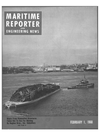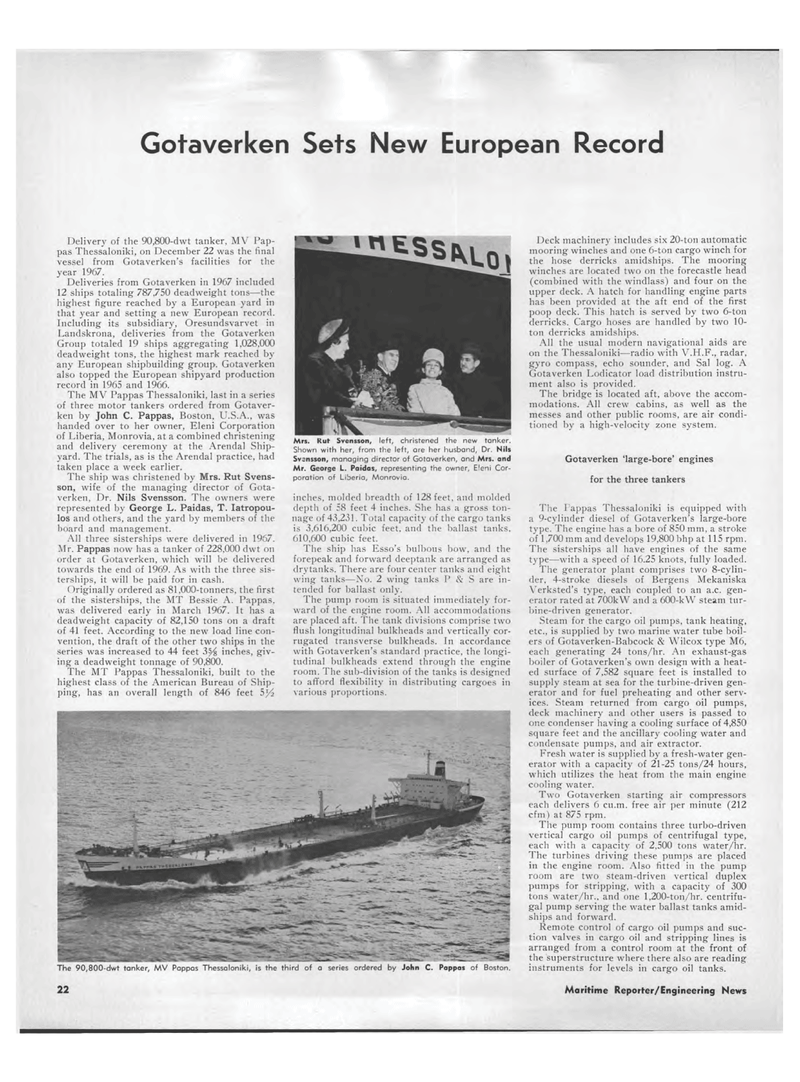
Page 20: of Maritime Reporter Magazine (February 1968)
Read this page in Pdf, Flash or Html5 edition of February 1968 Maritime Reporter Magazine
Gotaverken Sets New European Record Delivery of the 90,800-dwt tanker, MV Pap-pas Thessaloniki, on December 22 was the final vessel from Gotaverken's facilities for the year 1967. Deliveries from Gotaverken in 1967 included 12 ships totaling 787,750 deadweight tons?the highest figure reached by a European yard in that year and setting a new European record. Including its subsidiary, Oresundsvarvet in Landskrona, deliveries from the Gotaverken Group totaled 19 ships aggregating 1,028,000 deadweight tons, the highest mark reached by any European shipbuilding group. Gotaverken also topped the European shipyard production record in 1965 and 1966. The MV Pappas Thessaloniki, last in a series of three motor tankers ordered from Gotaver-ken by John C. Pappas, Boston, U.S.A., was handed over to her owner, Eleni Corporation of Liberia, Monrovia, at a combined christening and delivery ceremony at the Arendal Ship-yard. The trials, as is the Arendal practice, had taken place a week earlier. The ship was christened by Mrs. Rut Svens-son, wife of the managing director of Gota-verken, Dr. Nils Svensson. The owners were represented by George L. Paidas, T. Iatropou-los and others, and the yard by members of the board and management. All three sisterships were delivered in 1967. Mr. Pappas now has a tanker of 228,000 dwt on order at Gotaverken, which will be delivered towards the end of 1969. As with the three sis-terships, it will be paid for in cash. Originally ordered as 81,000-tonners, the first of the sisterships, the MT Bessie A. Pappas, was delivered early in March 1967. It has a deadweight capacity of 82,150 tons on a draft of 41 feet. According to the new load line con-vention, the draft of the other two ships in the series was increased to 44 feet 3$4 inches, giv-ing a deadweight tonnage of 90,800. The MT Pappas Thessaloniki, built to the highest class of the American Bureau of Ship-ping, has an overall length of 846 feet 5y> Mrs. Rut Svensson, left, christened the new tanker. Shown with her, from the left, are her husband, Dr. Nils Svansson, managing director of Gotaverken, and Mrs. and Mr. George L. Paidas, representing the owner, Eleni Cor-poration of Liberia, Monrovia. inches, molded breadth of 128 feet, and molded depth of 58 feet 4 inches. She has a gross ton-nage of 43,231. Total capacity of the cargo tanks is 3,616,200 cubic feet, and the ballast tanks. 610,600 cubic feet. The ship has Esso's bulbous bow, and the forepeak and forward deeptank are arranged as drytanks. There are four center tanks and eight wing tanks?No. 2 wing tanks P & S are in-tended for ballast only. The pump room is situated immediately for-ward of the engine room. All accommodations are placed aft. The tank divisions comprise two flush longitudinal bulkheads and vertically cor-rugated transverse bulkheads. In accordance with Gotaverken's standard practice, the longi-tudinal bulkheads extend through the engine room. The sub-division of the tanks is designed to afford flexibility in distributing cargoes in various proportions. Deck machinery includes six 20-ton automatic mooring winches and one 6-ton cargo winch for the hose derricks amidships. The mooring winches are located two on the forecastle head (combined with the windlass) and four on the upper deck. A hatch for handling engine parts has been provided at the aft end of the first poop deck. This hatch is served by two 6-ton derricks. Cargo hoses are handled by two 10-ton derricks amidships. All the usual modern navigational aids are on the Thessaloniki?radio with V.H.F., radar, gyro compass, echo sounder, and Sal log. A Gotaverken Lodicator load distribution instru-ment also is provided. The bridge is located aft, above the accom-modations. All crew cabins, as well as the messes and other public rooms, are air condi-tioned by a high-velocity zone system. Gotaverken 'large-bore' engines for the three tankers The Pappas Thessaloniki is equipped with a 9-cylinder diesel of Gotaverken's large-bore type. The engine has a bore of 850 mm, a stroke of 1,700 mm and develops 19,800 bhp at 115 rprn. The sisterships all have engines of the same type?with a speed of 16.25 knots, fully loaded. The generator plant comprises two 8-cylin-der, 4-stroke diesels of Bergens Mekaniska Verksted's type, each coupled to an a.c. gen-erator rated at 700kW and a 600-kW steam tur-bine-driven generator. Steam for the cargo oil pumps, tank heating, etc., is supplied by two marine water tube boil-ers of Gotaverken-Babcock & Wilcox type M6, each generating 24 tons/hr. An exhaust-gas boiler of Gotaverken's own design with a heat-ed surface of 7,582 square feet is installed to supply steam at sea for the turbine-driven gen-erator and for fuel preheating and other serv-ices. Steam returned from cargo oil pumps, deck machinery and other users is passed to one condenser having a cooling surface of 4,850 square feet and the ancillary cooling water and condensate pumps, and air extractor. Fresh water is supplied by a fresh-water gen-erator with a capacity of 21-25 tons/24 hours, which utilizes the heat from the main engine cooling water. Two Gotaverken starting air compressors each delivers 6 cu.m. free air per minute (212 cfm) at 875 rprn. The pump room contains three turbo-driven vertical cargo oil pumps of centrifugal type, each with a capacity of 2,500 tons water/hr. The turbines driving these pumps are placed in the engine room. Also fitted in the pump room are two steam-driven vertical duplex pumps for stripping, with a capacity of 300 tons water/hr., and one 1,200-ton/hr. centrifu-gal pump serving the water ballast tanks amid-ships and forward. Remote control of cargo oil pumps and suc-tion valves in cargo oil and stripping lines is arranged from a control room at the front of the superstructure where there also are reading instruments for levels in cargo oil tanks. The 90,800-dwt tanker, MV Pappas Thessaloniki, is the third of a series ordered by John C. Pappas of Boston. 22 Maritime Reporter/Engineering News

 19
19

 21
21
